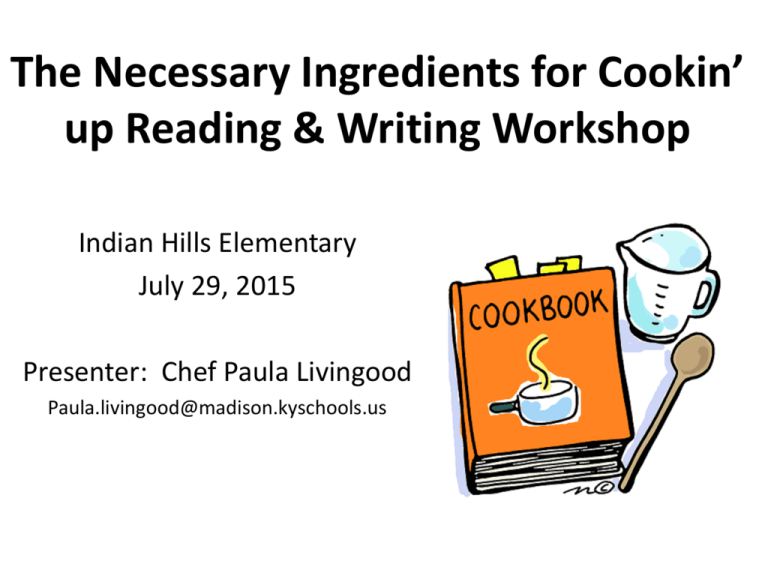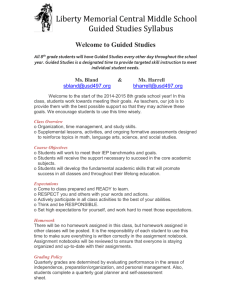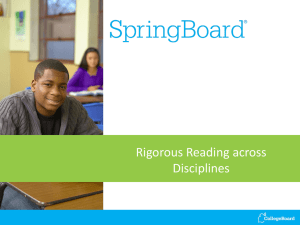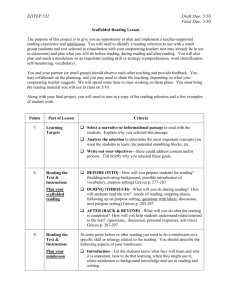Session One - Reading Workshop
advertisement

The Necessary Ingredients for Cookin’ up Reading & Writing Workshop Indian Hills Elementary July 29, 2015 Presenter: Chef Paula Livingood Paula.livingood@madison.kyschools.us Today’s “Menu”: 8:30-11:20 *The framework of Reading Workshop *Continuum orientation *Guided Reading lesson 11:30-12:30 *Lunch 12:30-3:00 *The framework of Writing Workshop *Guided Writing lesson *Writing prompts 15 years teaching experience: *4th Grade HR Teacher - seven years *Writing Intervention - four years (2nd – 5th) *5th Grade HR Teacher - three years *Writing Intervention & Support – SC and KV split S.C.E. 5th Grade Schedule 7:25-9:20 9:20-10:05 10:05-11:00 11:00-11:50 11:50-12:30 12:30-12:55 12:55-1:10 1:15-2:00 2:05 Reading Block (1 hr. 55 min.) Content Switch 1 (L.A./M/Science/S.S. in 45 min.) Content Switch 2 Content Switch 3 Content Switch 4 (HR) Lunch Recess Planning Load Busses Livingood Instructional Responsibilities Reading (HR) 115 min. daily L.A. Classes 45 min. x 4 switches daily S.C.E. 2013-2014 ODW KPREP Scores N A P D % P/D 4.8 5.8 6.8 10.7 11.5 18.2 2.5 57.1 63.5 52.3 2.5 27.4 19.2 22.7 62.5 84.5 82.7 75.0 95.0 Total students tested :84 63 % F/R tested: 52 Boys tested: 44 Girls tested : 40 S.C.E. 2013-2014 ODW and Reading KPREP Scores N A P D % P/D 4.8 19 10.7 17.9 57.1 40.5 27.4 27.6 84.5 63.1 ODW Scores Reading Scores Spotlight on today’s learning goals: • Understand the framework congruency and vital components that Reading Workshop and Writing Workshop need to include in order to meet CCSS • Make connections to the Danielson Framework for Teaching • Understand the importance of the gradual release of responsibility • Become familiar with the Continuum of Literacy Learning resource • Determine how to structure reading and writing lessons (minilessons and guided lessons) within a 90 minute weekly block • Design guided reading and guided writing lessons • Compose grade level writing prompts from leveled texts What constitutes effective reading instruction? Research says… Five Pillars of Effective Reading Instruction: (NRP, National Reading Panel research) Phonics —the acquisition of sound-letter correspondence and their use in reading and spelling. Phonemic Awareness —the manipulation of phonemes in spoken syllables and words. Vocabulary —the deep knowledge of word meaning used in speaking and writing. Fluency —the ability to orally read with speed, accuracy, and proper expression (prosody) Comprehension —intentional thinking about text in order to understand, remember, and communicate meaning from what has been read. Six T’s of Effective Literacy Instruction (R. Allington, Researcher) Time Instructional time focuses more on reading and writing opportunities such as guided and independent reading/writing. Text Appropriate level texts are available so that students can read with a high level of fluency, accuracy, and comprehension. Teaching Explicit demonstrations of cognitive strategies are modeled and instruction is offered in small group and whole group lessons. Talk Thoughtful classroom talk focuses on making children’s thinking visible and building understanding. Tasks Students are provided similar, but different tasks that integrate several content areas with more complexity. (Less skill sheets and with a focus on reading and writing workshop opportunities.) Testing Student work is evaluated based on effort and improvement. Why balanced literacy? Gradual Release of Responsibility Resources: Fountas and Pinnell Meet…your continuum book!! • Grades Pre K-2 or Grades 3-8 • Inside cover • Grade level tabs • Guided Reading A-Z • Glossary Sample Daily Literacy Schedule Reading Workshop (75 min.) • 8:00-8:15 CCS Mini Lesson with mentor text • 8:15-9:10 Rotations *Guided Reading Groups *Various Center Activities (Independent reading / computers/ ?) • 9:10-9:15 Share Out with the whole class • 9:15-9:35 Recess Word Study (25 min.) 9:35-10:00 Writing Workshop (1 hour) • 10:00-10:15 CCS Mini Lesson with mentor text • 10:15-10:50 Rotations *Guided Writing Groups *Various Center Activities (Independent writing / computers/ ?) • 10:50-11:00 Share out whole class “Workshop” terminology? F & P Three Block Framework Block 1: Language/Word Study Block 2: Reading Workshop Block 3: Writing Workshop 90 min. Focuses on Foundational and Language CCSS (Reading, Writing, Listening, and Speaking CCSS) Focuses on Literary and Informational Text, Writing, Listening, and Speaking CCSS Focuses Specifically on Narrative, Opinion/Argumentative, and Informative/Explanatory CCSS (Reading, Listening, and Speaking CCSS) Let’s take a trip through the framework blocks!! • The burning question: How you are going to incorporate all three blocks into a 90 reading/writing time? 90 Minutes Reading & Writing Workshop “Ingredients”: 1. Minilesson (10-20 min.) —Read Aloud/Modeled Reading OR Write Aloud/Modeled Writing (based on CCSS / Continuum) *lessons expose ALL students to grade level core instruction 2. Rotations (10-20 min.): • Guided Reading OR Guided Writing Instruction (Cont.) • Interactive/Shared Reading OR Interactive/Shared Writing (Cont.) *lessons are geared towards A-Z reading level / NEEDS of students • Independent Reading OR Independent Writing Instruction (Cont.) • Various Centers 3. Share/Feedback Time (5-10 min.) F & P Three Block Framework Block 1: Language/Word Study (~30-60 minutes) Block 2: Reading Workshop (~60-90 minutes) Block 3: Writing Workshop (~60 minutes) Focuses on Foundational and Language CCSS *Interactive Edit *Interactive Vocabulary *Handwriting Minilesson *Modeled or Shared Reading/Writing *Readers’ Theatre *Choral Reading *Word Study *Interactive Read Aloud *Reading and/or Writing Assessment Continuum per Grade Level: *Interactive Read-Aloud…, *Shared and Performance R…, *Phonics Spelling, and Word Study *Oral, Visual, and Technological Studies F & P Three Block Framework Block 1: Language/Word Study (~30-60 minutes) Block 2: Reading Workshop (~60-90 minutes) Focuses on Foundational and Language CCSS Focuses on Literary and Informational Text, Writing, Listening, and Speaking CCSS *Interactive Edit *Interactive Vocabulary *Handwriting Minilesson *Modeled or Shared Reading/Writing *Readers’ Theatre *Choral Reading *Word Study *Interactive Read Aloud *Reading and/or Writing Assessment 1. Minilesson/Modeling with Mentor Text 2. • • • Rotations: Guided Reading Instruction Independent Reading Various Centers 3. Share/Feedback Time Block 3: Writing Workshop (~60 minutes) F & P Three Block Framework Block 1: Language/Word Study (~30-60 minutes) Block 2: Reading Workshop (~60-90 minutes) Block 3: Writing Workshop (~60 minutes) Focuses on Foundational and Language CCSS Focuses on Literary and Informational Text, Writing, Listening, and Speaking CCSS Focuses Specifically on Narrative, Opinion/Argumentative, and Informative/Explanatory CCSS (Reading, Listening, and Speaking CCSS) *Interactive Edit *Interactive Vocabulary *Handwriting Minilesson *Modeled or Shared Reading/Writing *Readers’ Theatre *Choral Reading *Word Study *Interactive Read Aloud *Reading and/or Writing Assessment 1. Minilesson/Modeling with Mentor Text 1. Minilesson/Modeling with Mentor Text 2. • • • 2. • • • Rotations: Guided Reading Instruction Independent Reading Various Centers 3. Share/Feedback Time Rotations: Guided Writing Instruction Independent Writing Various Centers 3. Share/Feedback Time “…but my students write in reading ALL the time!!” Reading Workshop W to Learn (independently, interactively, or collaboratively) Writing Workshop W to Demonstrate Learning W for Authentic Audiences & Purposes Purpose gather knowledge or practice thinking while reading show what has been learned write to a real audience for a specific purpose (narrate, argument/opinion, inform/explain) Audience student teacher various & authentic Forms drawings—labels—beg. spelling—sentence, journals, various graphic organizers, GOs, blogging, etc. constructed responses-short answer & extended response products from a step of the writing process: letters, narratives, reports, essays, articles, speeches, etc. Reading and Writing ARE separate… …BUT intimately related processes! Reading CCSS Writing CCSS Connecting Reading and Writing • Mature readers constantly make connections between reading and writing. • When writers read, they notice possibilities to use within his/her own writing (new vocabulary, sentence variety, breaking rules, etc.). • Readers enjoy books and then use those same crafts to make his/her own writing enjoyable (humor, foreshadowing, predicting, etc.) • Beginning writers compose text that resembles features and styles of the text that has been read. Connecting Reading and Writing • As students become “stronger” readers, he/she become “stronger” writers. • As students have opportunities to write, so then it strengthens his/her reading ability. Literacy Framework Block 1: Language/Word Study (~30-60 minutes) Block 2: Reading Workshop (~60-90 minutes) Block 3: Writing Workshop (~60 minutes) Focuses on Foundational and Language CCSS Focuses on Literary and Informational Text, Writing, Listening, and Speaking CCSS Focuses Specifically on Narrative, Opinion/Argumentative, and Informative/Explanatory CCSS (Reading, Listening, and Speaking CCSS) *Interactive Edit *Interactive Vocabulary *Handwriting Minilesson *Modeled or Shared Reading/Writing *Readers’ Theatre *Choral Reading *Word Study *Interactive Read Aloud *Reading and/or Writing Assessment 1. Minilesson/Modeling with Mentor Text 1. Minilesson/Modeling with Mentor Text 2. • • • 2. • • • Rotations: Guided Reading Instruction Independent Reading Various Centers 3. Share/Feedback Time Rotations: Guided Writing Instruction Independent Writing Various Centers 3. Share/Feedback Time Language / Word Study Video: Mentor Text & Interactive Writing in Kindergarten Language / Word Study Interactive Dialogue Editing in 5th Language / Word Study *Morning Message Interactive Editing in Kindergarten Language / Word Study *Reader’s Theater on Figurative Language *in 5th grade L.A. content switch Language / Word Study *Human spelling *L.A. content switch Reading Workshop Block 1: Language/Word Study (~30-60 minutes) Block 2: Reading Workshop (~60-90 minutes) Block 3: Writing Workshop (~60 minutes) Focuses on Foundational and Language CCSS Focuses on Literary and Informational Text, Writing, Listening, and Speaking CCSS Focuses Specifically on Narrative, Opinion/Argumentative, and Informative/Explanatory CCSS (Reading, Listening, and Speaking CCSS) *Interactive Edit *Interactive Vocabulary *Handwriting Minilesson *Modeled or Shared Reading/Writing *Readers’ Theatre *Choral Reading *Word Study *Interactive Read Aloud *Reading and/or Writing Assessment 1. Minilesson/Modeling with Mentor Text 1. Minilesson/Modeling with Mentor Text 2. • • • 2. • • • Rotations: Guided Reading Instruction Independent Reading Various Centers 3. Share/Feedback Time Rotations: Guided Writing Instruction Independent Writing Various Centers 3. Share/Feedback Time Setting up Reading Workshop • Teach students how to work independently during rotations away from you (gradual release model) • Resource excerpt pgs. 6-13 from The Next Step in Guided Reading © 2009 by Jan Richardson, Scholastic Professional (online) Reading Workshop “Ingredients” 1. CCSS Minilesson/Modeling with Mentor Text 2. Rotations: • Guided Reading Instruction • Independent Reading (Practice) • Various Centers (Practice) 3. Share/Feedback Time The “Perks” of Reading Workshop • Students hear fluent reading and think alouds to understand the reading process • Creates a community of learners who learn from one another • Highly structured and predictable = on task behaviors • Differentiated instruction: teaches students at his/her instructional level through a guided reading approach The “Perks” of Reading Workshop • Students practice modeled lessons and process thinking in writing to learn activities • Students have the opportunity to frequently reflect upon his/her growth as a reader and can set goals • KPREP scores will reflect rigor and relevance of effective reading instruction within your school 1. Minilesson Planning Components: • Lesson Introduction & Connections • Teaching/Modeling/ Read Aloud/Book Talk • Active Engagement • Link Time: • Depends on age level • Varies from 10-30 minutes Template provided 1. Minilesson • Video clip • https://www.youtube.com/watch?v=5Gu5O5ro7zs& feature=player_detailpage • (Lucy Calkins Whole Class Instruction in Perspective and Point of View grades 5-8) Minilessons on How to Use Comprehension Strategies • Strategies overview handout provided • “Into the Book” website • Interactive Read Alouds matrix (Linda Hoyt) on website • Strategies that Work, by Harvey & Goudvis 1. Minilesson Planning • See lesson plan template • Minilessons are based upon CCSS • Can also result from observations/needs of the MAJORITY of your students 2. Guided Reading 2. Guided Reading Planning AFTER assessing all students with the F & P assessment: • Homogeneously grouped: read at about same level, demonstrate similar reading behaviors, and share similar instructional needs (see GR A=Z tab) • Size can be 3-8 students (CAREFUL!! need time to “tap on and tap off” with all) • Temporary groups that change as you assess students’ growth and needs 2. Guided Reading Planning Fountas & Pinnell Criteria for Instructional Level Reading: • At levels A‐K: 90‐94% accuracy with excellent or satisfactory comprehension or 95‐100% accuracy with limited comprehension. • At levels L‐Z: 95‐97% accuracy with excellent or satisfactory comprehension or 98‐100% accuracy with limited comprehension. 2. Guided Reading Planning The Reading Process: Before—During—After 2. Guided Reading Structure • Select text that meets needs of group • Introduce text or new section of text (vocabulary that might impede comprehension!!) • Teach/reinforce for processing strategies – Students read the text INDIVIDUALLY (tap to hear individuals read and keep anecdotals of thinking within the text – Discuss / revisit text (thinking about and beyond the text) 2. Guided Reading Structure • Word work (optional) • Extending the meaning of the text (see Writing About Reading tab) • *See “Ten Text Characteristics for Guided Reading” handout • *Go to Guided Reading A – Z tab Know the text BEFORE reading with students!! • Level vs. teacher • Inappropriate content 2. Guided Reading Planning • See lesson plan template 2. Guided Reading Planning • Video Clip (1st Day of GR following Jan Richardson model) • https://www.youtube.com/watch?v=AOj3281 eNGg&feature=player_detailpage • Setting up “Guided Reading K-2” handouts provided Listening to Students Read • Reading goal = make meaning • Keep records as you listen to students (see tracking chart) • Specific training in August-- Readers use information sources to make meaning (MSV): – Semantic (meaning) Does that make sense? • prior knowledge, story sense, text, illustrations – Syntactic (structure) Does that look right? • natural language, knowledge of English, grammatical patterns, and language structures – Graphophonic (visual) Does that sound right? • sounds and symbols, print conventions, directionality, words/spaces, letters, beginning/ending, punctuation 2. Independent Reading 2. Independent Reading • Enables students to practice reading “just right” texts in connection to the minilesson • Enjoy reading texts of choice Fountas & Pinnell Criteria for Independent Level Reading: • At levels A‐K: 95‐100% accuracy with excellent or satisfactory comprehension. • At levels L‐Z: 98‐100% accuracy with excellent or satisfactory comprehension. Classroom Library • Genres labeled • Favorite authors • Topics • Themes • Series • Magazines **F & P levels are labeled within each book 2. Literacy Centers • Resource excerpt pgs. 13-16 from The Next Step in Guided Reading © 2009 by Jan Richardson, Scholastic Professional (on website) • Assignment due dates posted • Rigor and relevance!! • Rotation schedule visible 2. Literacy Centers Book Clubs • Teach students (grades 3 and up) HOW to independently discuss books at a “high level” • Video clip on website Center Expectations to Model: • • • • • How to rotate How to start and finish within each area Appropriate voice level Clean up of materials Establish bathroom 911 procedures Access to Needed Materials Individual bins: *reader’s notebook *reading folder *books that are being read *writer’s notebook *writing folder *task models visible Technology Center • Post task directions on classroom website or chart paper • Post exemplary blog models – Kidblog.org – Learn2earn.org Working with Words Center • Post/have copies of “words to learn” list, personal words to know, vocab words, etc. • Letter tiles • Dry erase boards and markers • Pencil and paper 3. Share Time • Give specific feedback on observations • Ask students to evaluate his/her work during the workshop (did well? need to improve?) • Goal setting • Ask a student to share of independent text read through a book talk, written response, how used minilesson strategy, etc. • Invite students to share about his/her learning – Whole group – Post-it note – Turn and talk 3. Share Time • Video clip – 3rd grade • https://www.youtube.com/watch?v=1XASmzDki0&feature=player_detailpage Literacy / Data Notebook • Reading AND writing tabs • Conference records • Use notes to group students for guided writing • Exemplary models on hand • Book level tracking chart Formative Assessment in Reading Workshop • How do you know if your students are “getting it?” • Reading to and with • Observing and listening to students read and keeping anecdotals • Verbal and written responses • Sample self-evaluation provided • Video Clip: http://www.ket.org/education/video/ksenb/ksenb_0 00181.htm #um Guided Reading Lesson Planning • See template • Select a book level within your grade (see text gradient handout) • Refer to “Guided Reading” tab in the Continuum • Plan a GR lesson using this book • Higher levels (chapter books) will only select an excerpt/portion of the text Guided Reading Lesson Planning • Who would like to demonstrate this GR lesson?







